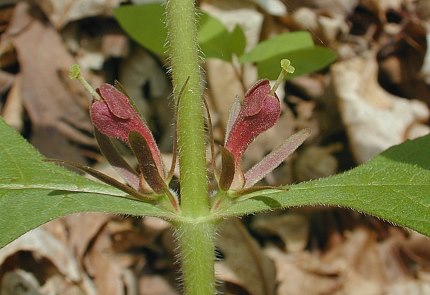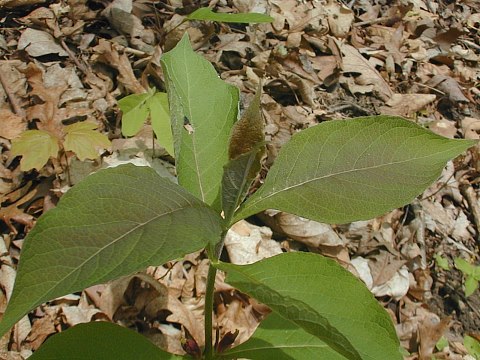Description: This perennial wildflower is 2-4' tall and unbranched. The central stem is light green, terete, and covered with spreading white hairs that are non-glandular. Pairs of opposite leaves occur at intervals along this stem; each pair of leaves rotates 90º from the orientation of the preceding pair of leaves. Each leaf is up to 8" long and 3½" across, narrowly ovate to ovate in shape, and smooth along its margins, tapering to a narrow sessile base. The upper surface of each leaf is dull green to dull reddish green, while its lower surface is whitish green and covered with short fine pubescence. Flowers occur individually in the axils of the leaves. Each flower has a narrow tubular corolla that is reddish brown and about ½-¾" long. The corolla has 5 lobes that are short and well-rounded. The 5 sepals are about the same length as the corolla and linear in shape; they are green to dark reddish brown. At the base of the flower, there is a 3-celled ovary that is green and hairy; there is also a pair bracts that resemble the sepals, except they are smaller in size. The style is about the same length or slightly exerted from the corolla; it has a knobby green stigma. The 5 stamens are hidden with the corolla.

The blooming period occurs from late spring to early summer and lasts about 1-2 months. Each flower is replaced by a dry drupe about ½" long that is globoid-ovoid in shape and becomes orange or orange-red at maturity. Inside each drupe, there are 3 black nutlets that are 3-angled and oblongoid in shape. The root system consists of a taproot. This wildflower spreads by reseeding itself.
Cultivation:
The
preference is light shade to dappled sunlight, mesic to slightly dry
conditions, and a loamy or rocky soil with abundant organic matter.
Range & Habitat:
Illinois Horse Gentian is occasional in most areas of the state (see Distribution
Map), where it is native. Habitats include upland deciduous
woodlands, rocky
wooded slopes, and thinly wooded bluffs. Rarely is this species found
in prairies.
Faunal Associations:
The nectar of the flowers attracts long-tongued bees, especially
bumblebees (Bombus spp.) and Anthophorid bees (Anthophora
spp.). Smaller short-tongued bees may visit the flowers, but
they are less effective at cross-pollination. The caterpillars of the
moth Hemaris diffinis (Snowberry Clearwing) feed on
Triosteum spp. (Horse Gentians) and other members
of the Honeysuckle family.

Photographic
Location:
A wooded slope near Charleston, Illinois.
Comments:
In spite of the common name, this wildflower is not a gentian (a member
of the Gentianaceae); it is more closely related to the honeysuckles.
Illinois Horse Gentian differs from the typical variety of Triosteum
aurantiacum by the long non-glandular hairs along its stem;
the typical variety has some glandular hairs along its stem that are
often shorter. Some taxonomic botanists in Illinois consider Illinois
Horse Gentian to be a separate species, Triosteum illinoense;
however, this reclassification hasn't gained much acceptance from
taxonomic botanists outside of the state. Another similar species, Triosteum
perfoliatum (Perfoliate Horse Gentian), has opposite leaves
that are joined together at the base and surround the stem; the
opposite leaves of Illinois Horse Gentian are sessile and remain
distinct.